Gregor Stiglic
UM_FHS at TREC 2024 PLABA: Exploration of Fine-tuning and AI agent approach for plain language adaptations of biomedical text
Feb 19, 2025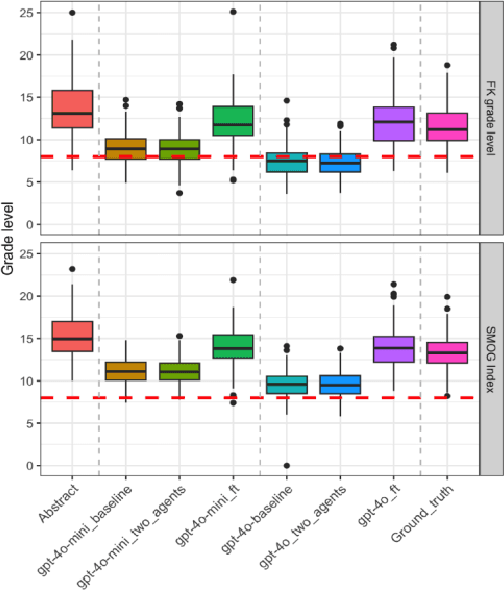
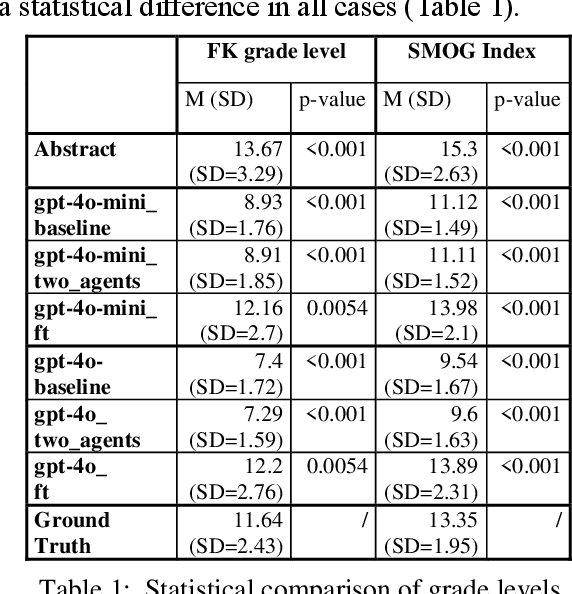

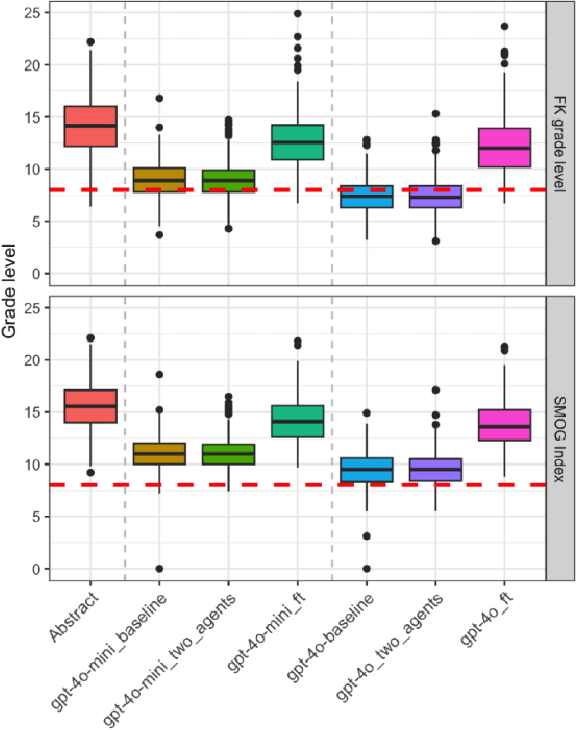
Abstract:This paper describes our submissions to the TREC 2024 PLABA track with the aim to simplify biomedical abstracts for a K8-level audience (13-14 years old students). We tested three approaches using OpenAI's gpt-4o and gpt-4o-mini models: baseline prompt engineering, a two-AI agent approach, and fine-tuning. Adaptations were evaluated using qualitative metrics (5-point Likert scales for simplicity, accuracy, completeness, and brevity) and quantitative readability scores (Flesch-Kincaid grade level, SMOG Index). Results indicated that the two-agent approach and baseline prompt engineering with gpt-4o-mini models show superior qualitative performance, while fine-tuned models excelled in accuracy and completeness but were less simple. The evaluation results demonstrated that prompt engineering with gpt-4o-mini outperforms iterative improvement strategies via two-agent approach as well as fine-tuning with gpt-4o. We intend to expand our investigation of the results and explore advanced evaluations.
Chapter 7 Review of Data-Driven Generative AI Models for Knowledge Extraction from Scientific Literature in Healthcare
Nov 18, 2024



Abstract:This review examines the development of abstractive NLP-based text summarization approaches and compares them to existing techniques for extractive summarization. A brief history of text summarization from the 1950s to the introduction of pre-trained language models such as Bidirectional Encoder Representations from Transformer (BERT) and Generative Pre-training Transformers (GPT) are presented. In total, 60 studies were identified in PubMed and Web of Science, of which 29 were excluded and 24 were read and evaluated for eligibility, resulting in the use of seven studies for further analysis. This chapter also includes a section with examples including an example of a comparison between GPT-3 and state-of-the-art GPT-4 solutions in scientific text summarisation. Natural language processing has not yet reached its full potential in the generation of brief textual summaries. As there are acknowledged concerns that must be addressed, we can expect gradual introduction of such models in practise.
Identifying and Decomposing Compound Ingredients in Meal Plans Using Large Language Models
Nov 08, 2024Abstract:This study explores the effectiveness of Large Language Models in meal planning, focusing on their ability to identify and decompose compound ingredients. We evaluated three models-GPT-4o, Llama-3 (70b), and Mixtral (8x7b)-to assess their proficiency in recognizing and breaking down complex ingredient combinations. Preliminary results indicate that while Llama-3 (70b) and GPT-4o excels in accurate decomposition, all models encounter difficulties with identifying essential elements like seasonings and oils. Despite strong overall performance, variations in accuracy and completeness were observed across models. These findings underscore LLMs' potential to enhance personalized nutrition but highlight the need for further refinement in ingredient decomposition. Future research should address these limitations to improve nutritional recommendations and health outcomes.
EXMOS: Explanatory Model Steering Through Multifaceted Explanations and Data Configurations
Feb 01, 2024



Abstract:Explanations in interactive machine-learning systems facilitate debugging and improving prediction models. However, the effectiveness of various global model-centric and data-centric explanations in aiding domain experts to detect and resolve potential data issues for model improvement remains unexplored. This research investigates the influence of data-centric and model-centric global explanations in systems that support healthcare experts in optimising models through automated and manual data configurations. We conducted quantitative (n=70) and qualitative (n=30) studies with healthcare experts to explore the impact of different explanations on trust, understandability and model improvement. Our results reveal the insufficiency of global model-centric explanations for guiding users during data configuration. Although data-centric explanations enhanced understanding of post-configuration system changes, a hybrid fusion of both explanation types demonstrated the highest effectiveness. Based on our study results, we also present design implications for effective explanation-driven interactive machine-learning systems.
* This is a pre-print version only for early release. Please view the conference published version from ACM CHI 2024 to get the latest version of the paper
Lessons Learned from EXMOS User Studies: A Technical Report Summarizing Key Takeaways from User Studies Conducted to Evaluate The EXMOS Platform
Oct 03, 2023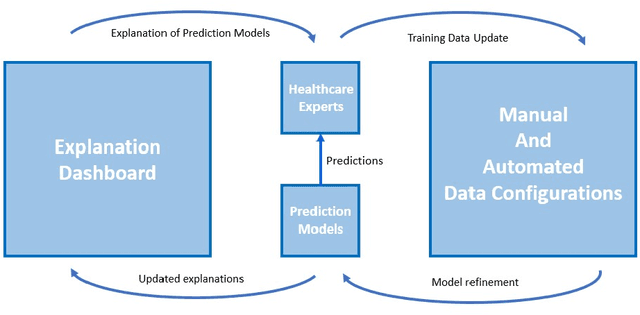
Abstract:In the realm of interactive machine-learning systems, the provision of explanations serves as a vital aid in the processes of debugging and enhancing prediction models. However, the extent to which various global model-centric and data-centric explanations can effectively assist domain experts in detecting and resolving potential data-related issues for the purpose of model improvement has remained largely unexplored. In this technical report, we summarise the key findings of our two user studies. Our research involved a comprehensive examination of the impact of global explanations rooted in both data-centric and model-centric perspectives within systems designed to support healthcare experts in optimising machine learning models through both automated and manual data configurations. To empirically investigate these dynamics, we conducted two user studies, comprising quantitative analysis involving a sample size of 70 healthcare experts and qualitative assessments involving 30 healthcare experts. These studies were aimed at illuminating the influence of different explanation types on three key dimensions: trust, understandability, and model improvement. Results show that global model-centric explanations alone are insufficient for effectively guiding users during the intricate process of data configuration. In contrast, data-centric explanations exhibited their potential by enhancing the understanding of system changes that occur post-configuration. However, a combination of both showed the highest level of efficacy for fostering trust, improving understandability, and facilitating model enhancement among healthcare experts. We also present essential implications for developing interactive machine-learning systems driven by explanations. These insights can guide the creation of more effective systems that empower domain experts to harness the full potential of machine learning
Improving Primary Healthcare Workflow Using Extreme Summarization of Scientific Literature Based on Generative AI
Jul 24, 2023
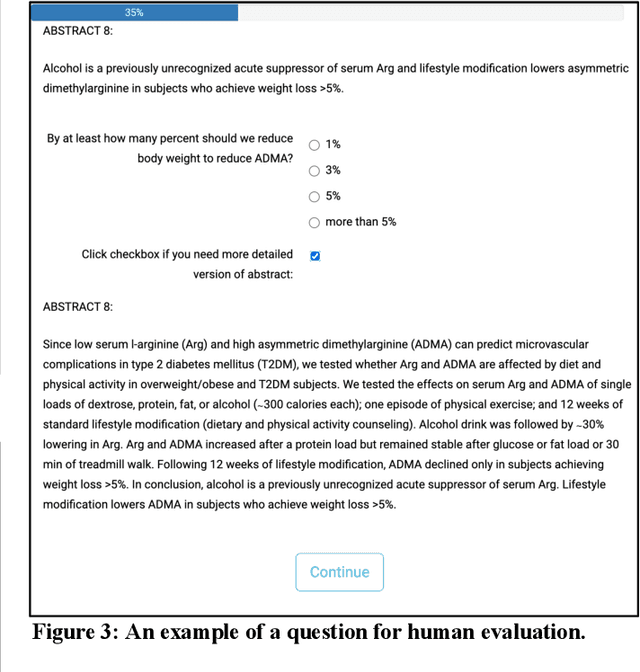
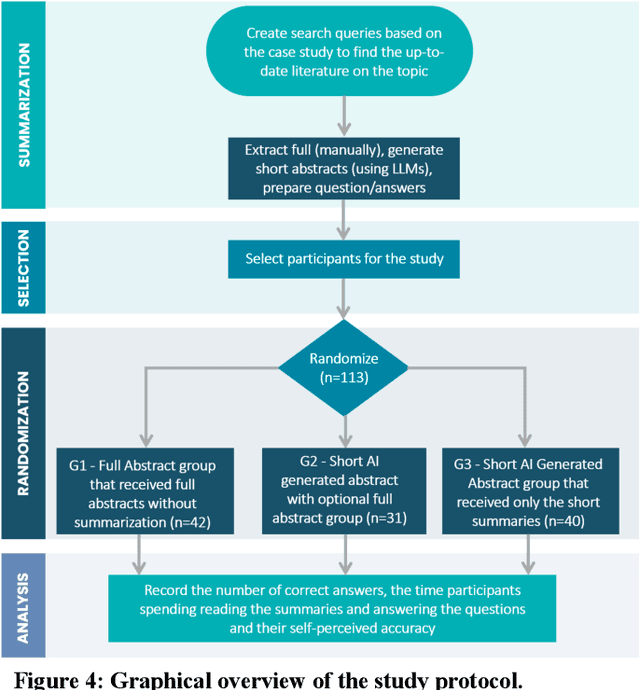
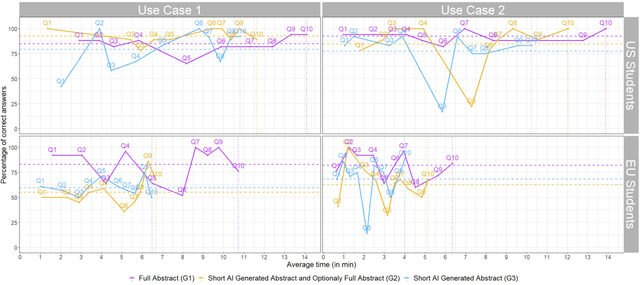
Abstract:Primary care professionals struggle to keep up to date with the latest scientific literature critical in guiding evidence-based practice related to their daily work. To help solve the above-mentioned problem, we employed generative artificial intelligence techniques based on large-scale language models to summarize abstracts of scientific papers. Our objective is to investigate the potential of generative artificial intelligence in diminishing the cognitive load experienced by practitioners, thus exploring its ability to alleviate mental effort and burden. The study participants were provided with two use cases related to preventive care and behavior change, simulating a search for new scientific literature. The study included 113 university students from Slovenia and the United States randomized into three distinct study groups. The first group was assigned to the full abstracts. The second group was assigned to the short abstracts generated by AI. The third group had the option to select a full abstract in addition to the AI-generated short summary. Each use case study included ten retrieved abstracts. Our research demonstrates that the use of generative AI for literature review is efficient and effective. The time needed to answer questions related to the content of abstracts was significantly lower in groups two and three compared to the first group using full abstracts. The results, however, also show significantly lower accuracy in extracted knowledge in cases where full abstract was not available. Such a disruptive technology could significantly reduce the time required for healthcare professionals to keep up with the most recent scientific literature; nevertheless, further developments are needed to help them comprehend the knowledge accurately.
Directive Explanations for Monitoring the Risk of Diabetes Onset: Introducing Directive Data-Centric Explanations and Combinations to Support What-If Explorations
Feb 21, 2023Abstract:Explainable artificial intelligence is increasingly used in machine learning (ML) based decision-making systems in healthcare. However, little research has compared the utility of different explanation methods in guiding healthcare experts for patient care. Moreover, it is unclear how useful, understandable, actionable and trustworthy these methods are for healthcare experts, as they often require technical ML knowledge. This paper presents an explanation dashboard that predicts the risk of diabetes onset and explains those predictions with data-centric, feature-importance, and example-based explanations. We designed an interactive dashboard to assist healthcare experts, such as nurses and physicians, in monitoring the risk of diabetes onset and recommending measures to minimize risk. We conducted a qualitative study with 11 healthcare experts and a mixed-methods study with 45 healthcare experts and 51 diabetic patients to compare the different explanation methods in our dashboard in terms of understandability, usefulness, actionability, and trust. Results indicate that our participants preferred our representation of data-centric explanations that provide local explanations with a global overview over other methods. Therefore, this paper highlights the importance of visually directive data-centric explanation method for assisting healthcare experts to gain actionable insights from patient health records. Furthermore, we share our design implications for tailoring the visual representation of different explanation methods for healthcare experts.
Local Interpretability of Calibrated Prediction Models: A Case of Type 2 Diabetes Mellitus Screening Test
Jun 02, 2020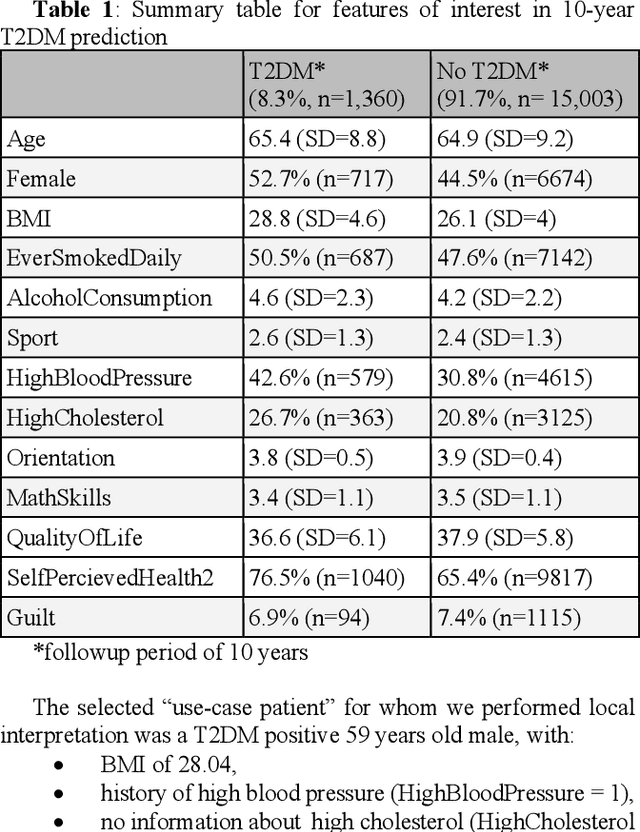
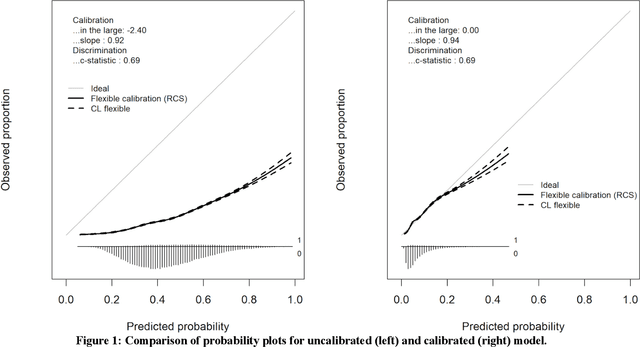
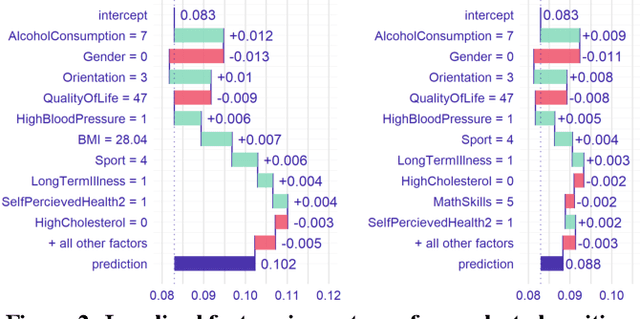
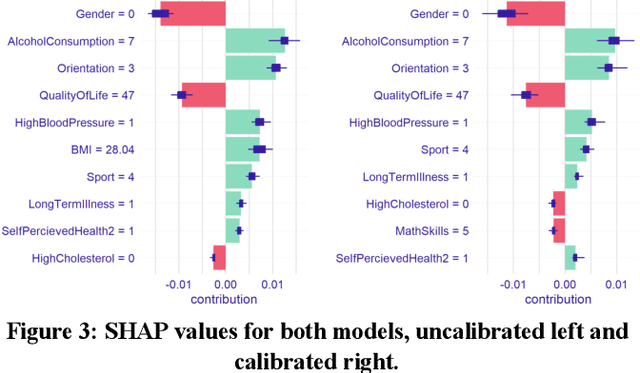
Abstract:Machine Learning (ML) models are often complex and difficult to interpret due to their 'black-box' characteristics. Interpretability of a ML model is usually defined as the degree to which a human can understand the cause of decisions reached by a ML model. Interpretability is of extremely high importance in many fields of healthcare due to high levels of risk related to decisions based on ML models. Calibration of the ML model outputs is another issue often overlooked in the application of ML models in practice. This paper represents an early work in examination of prediction model calibration impact on the interpretability of the results. We present a use case of a patient in diabetes screening prediction scenario and visualize results using three different techniques to demonstrate the differences between calibrated and uncalibrated regularized regression model.
Interpretability of machine learning based prediction models in healthcare
Feb 20, 2020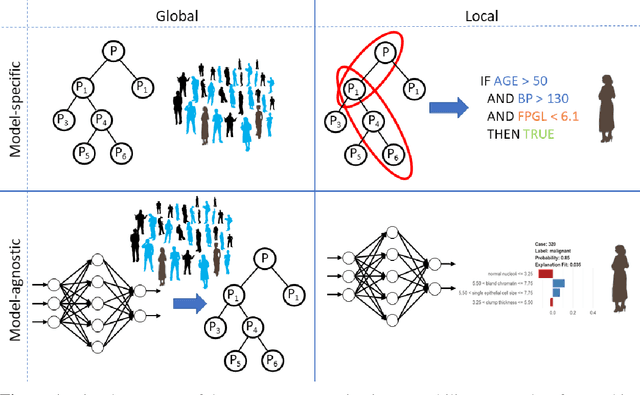
Abstract:There is a need of ensuring machine learning models that are interpretable. Higher interpretability of the model means easier comprehension and explanation of future predictions for end-users. Further, interpretable machine learning models allow healthcare experts to make reasonable and data-driven decisions to provide personalized decisions that can ultimately lead to higher quality of service in healthcare. Generally, we can classify interpretability approaches in two groups where the first focuses on personalized interpretation (local interpretability) while the second summarizes prediction models on a population level (global interpretability). Alternatively, we can group interpretability methods into model-specific techniques, which are designed to interpret predictions generated by a specific model, such as a neural network, and model-agnostic approaches, which provide easy-to-understand explanations of predictions made by any machine learning model. Here, we give an overview of interpretability approaches and provide examples of practical interpretability of machine learning in different areas of healthcare, including prediction of health-related outcomes, optimizing treatments or improving the efficiency of screening for specific conditions. Further, we outline future directions for interpretable machine learning and highlight the importance of developing algorithmic solutions that can enable machine-learning driven decision making in high-stakes healthcare problems.
 Add to Chrome
Add to Chrome Add to Firefox
Add to Firefox Add to Edge
Add to Edge